The battle
Along with many other Englishmen, the young Hugh Calveley served in Brittany, supporting Jean de Montfort's English-backed bid to become Duke of Brittany against the French-backed claimant, Charles de Blois, during the Breton War of Succession.
In 1354, Calveley was captain of the English-held fortress of Bécherel. He planned a raid on the castle of Montmuran on 10 April, to capture Arnoul d'Audrehem, Marshal of France, who was a guest of the lady of Tinteniac. Bertrand du Guesclin, in one of the early highlights of his career, anticipated the attack, posting archers as sentries. When the sentries raised the alarm at Calveley's approach, du Guesclin and d'Audrehem hurried to intercept. In the ensuing fight, Calveley was unhorsed by a knight named Enguerrand d'Hesdin, captured, and later ransomed.

Charles V, called the Wise, was King of France from 1364 to his death in 1380. His reign marked an early high point for France during the Hundred Years' War as his armies recovered much of the territory held by the English and successfully reversed the military losses of his predecessors.

The Battle of Auray took place on 29 September 1364 at the Breton-French town of Auray. This battle was the decisive confrontation of the Breton War of Succession, a part of the Hundred Years' War.
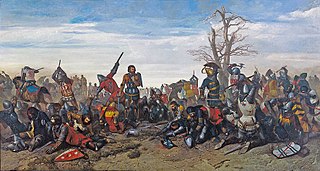
The Combat of the Thirty, occurring on 26 March 1351, was an episode in the Breton War of Succession fought to determine who would rule the Duchy of Brittany. It was an arranged fight between selected combatants from both sides of the conflict, fought at a site midway between the Breton castles of Josselin and Ploërmel among 30 champions, knights, and squires on each side. The challenge was issued by Jean de Beaumanoir, a captain of Charles of Blois supported by King Philip VI of France, to Robert Bemborough, a captain of Jean de Montfort supported by Edward III of England.
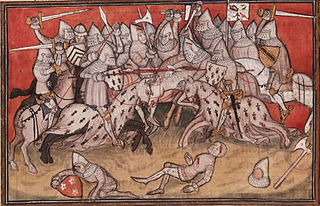
The War of the Breton Succession was a conflict between the Counts of Blois and the Montforts of Brittany for control of the Sovereign Duchy of Brittany, then a fief of the Kingdom of France. It was fought between 1341 and 12 April 1365. It is also known as the War of the Two Jeannes due to the involvement of two rival duchesses of that name.

Bertrand du Guesclin, nicknamed "The Eagle of Brittany" or "The Black Dog of Brocéliande", was a Breton knight and an important military commander on the French side during the Hundred Years' War. From 1370 to his death, he was Constable of France for King Charles V. Well known for his Fabian strategy, he took part in seven pitched battles and won the five in which he held command.

Sir Robert Knolles or Knollys was an important English knight of the Hundred Years' War, who, operating with the tacit support of the crown, succeeded in taking the only two major French cities, other than Calais and Poitiers, to fall to Edward III. His methods, however, earned him infamy as a freebooter and a ravager: the ruined gables of burned buildings came to be known as "Knollys' mitres".

Arnoul d'Audrehem was a Marshal of France, who fought in the Hundred Years' War.
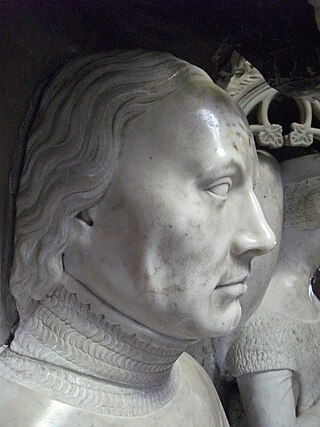
Olivier V de Clisson, nicknamed "The Butcher", was a Breton soldier, the son of Olivier IV de Clisson. His father had been put to death by the French in 1343 on the suspicion of having willingly given up the city of Vannes to the English.

Bécherel is a commune in the Ille-et-Vilaine department in Brittany in northwestern France.

The Battle of Nájera, also known as the Battle of Navarrete, was fought on 3 April 1367 to the northeast of Nájera, in the province of La Rioja, Castile. It was an episode of the first Castilian Civil War which confronted King Peter of Castile with his half-brother Count Henry of Trastámara who aspired to the throne; the war involved Castile in the Hundred Years' War. Castilian naval power, far superior to that of France or England, encouraged the two polities to take sides in the civil war, to gain control over the Castilian fleet.

The Battle of Cocherel was fought on 16 May 1364 between the forces of Charles V of France and the forces of Charles II of Navarre, over the succession to the dukedom of Burgundy. The result was a French victory.
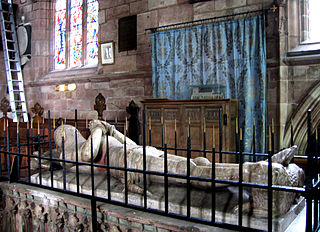
Sir Hugh Calveley was an English knight and commander, who took part in the Hundred Years' War, gaining fame during the War of the Breton Succession and the Castilian Civil War. He held various military posts in Brittany and Normandy. He should not be confused with his nephew, also Sir Hugh Calveley, who died in June 1393 and was Member of Parliament for Rutland.

Jean, or Jehan de Beaumanoir, marshal of Brittany for Charles of Blois, and captain of Josselin, is remembered for his share in the famous Combat of the Thirty during the War of Breton Succession (1341–1364) between the warring parties of competing claimants for the Dukedom.

The Caroline War was the second phase of the Hundred Years' War between France and England, following the Edwardian War. It was so-named after Charles V of France, who resumed the war nine years after the Treaty of Brétigny. In this part of the conflict, the Crown of Castile emerges as a supporter of France. The Kingdom of France dominated this phase of the war.
Events from the 1350s in England.

The Battle of Pontvallain, part of the Hundred Years' War, took place in the Sarthe region of north-west France on 4 December 1370, when a French army under Bertrand du Guesclin heavily defeated an English force which had broken away from an army commanded by Sir Robert Knolles. The French numbered 5,200 men, and the English force was approximately the same size.

The siege of Rennes was an episode in the War of the Breton Succession during 1356-1357.
Guillaume Boitel, was a knight and the faithful companion of the French knight Bertrand Du Guesclin. He was originally sent by king Charles V of France to assist Du Guesclin during the Anglo-French war in Normandy and the Breton War of Succession between Charles de Blois and Jean de Montfort (1363-1364).

Raoul de Caours was a Breton knight who served both the English and French during the Hundred Years' War.
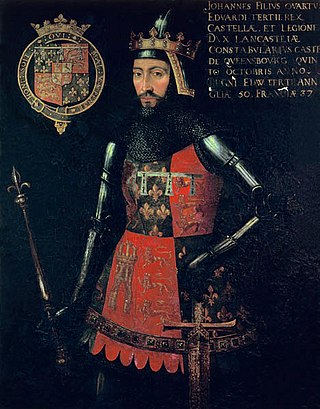
John of Gaunt's chevauchée of 1373 was an English military raid at the end of the second period of the Hundred Years' War by John of Gaunt, Duke of Lancaster, from his departure from Calais in August 1373 to his arrival at Bordeaux at the end of December 1373.

















